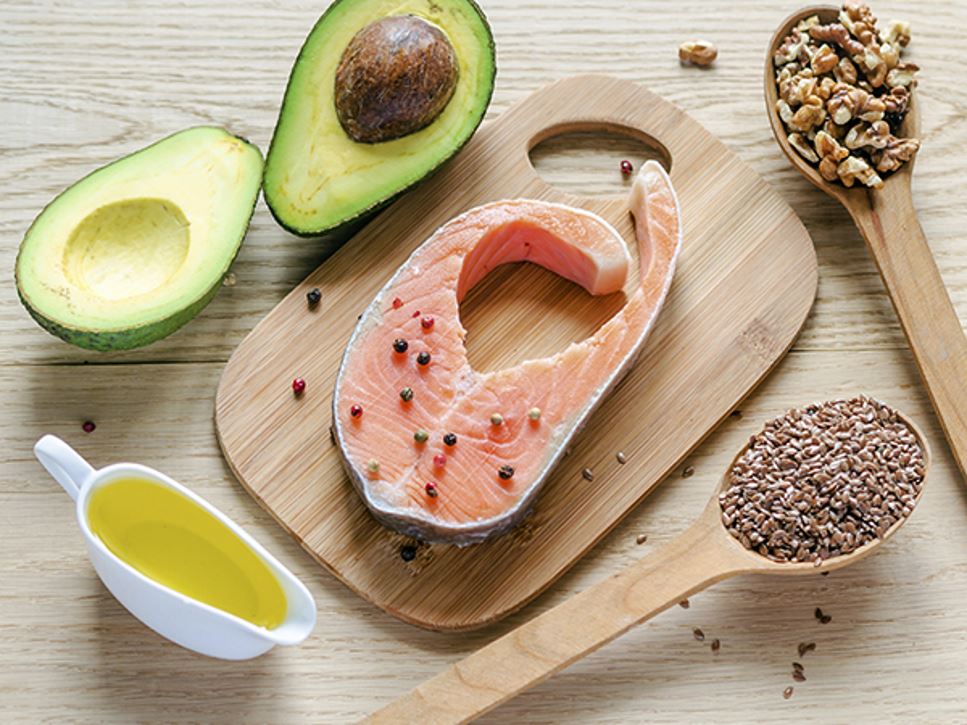It used to be that all types of dietary fat got a bad rap. Now, there are countless news stories touting the benefits of fat. So, what’s true? Different types of fat play a different role in your health. Some types of fat have been shown to have health benefits, whereas others are related to health risks. A good standard to go by is to replace foods higher in saturated fat with foods higher in unsaturated fats to promote health.
A nutritious eating plan doesn't mean cutting out all fat — just focusing on healthier varieties. Not sure how to get started? Begin by making small changes. A general goal is for 20% to 35% of your total daily calories to come from healthy fats, such as polyunsaturated and monounsaturated fats, and fewer than 10% of calories per day from saturated fats.
The Omegas
Omega-3 fats are a type of polyunsaturated fatty acid that may offer health benefits, such as:
- Promoting normal functions of the brain and nervous system
- Lowering cholesterol levels and supporting heart health
- Protecting against dry eye disease
- Reducing inflammation in the body
There are three main types of omega-3 fatty acids we get from food. Their scientific names, which can be tongue twisters, relate to their chemical structures. So, they are often referred to by three-letter acronyms:
- ALA, or alpha-linolenic acid
- DHA, or docosahexaenoic acid
- EPA, or eicosapentaenoic acid
The body cannot make omega-3 fatty acids, so you must get them through the foods you eat. Some foods and beverages may be fortified with omega-3s, for example, eggs, milk and soy drinks. The body can convert the ALA you get from food into DHA and EPA. However, the amount made is limited, so including a variety of foods in your day is important. Some people may benefit from a supplement, but be sure to discuss it first with a health care provider.
What to Eat
- Fatty fish: Include fish high in omega-3 fats at least twice per week. For example, salmon, herring, sardines, lake trout and Atlantic or Pacific mackerel.
- Walnuts: Walnuts are a plant-based source of omega-3 fatty acids. Add walnuts to cereal, salads or muffins. Try walnut oil in salad dressings and sauces.
- Flaxseed: Your body cannot break down whole flaxseeds to access the omega-3-containing oil, so to get the health benefits, select ground flaxseed. Add it to breakfast cereal, yogurt, baked goods including breads and muffins, or mixed dishes and casseroles. You also can drizzle flaxseed oil over quinoa or use it for salad dressing.
- Chia seeds: These small seeds are packed with nutrients. In addition to omega-3s, they contain protein, dietary fiber, vitamins and minerals. Toss them into your cereal, salads and even baked goods.
- Hemp seeds: These seeds also are packed with omega-3s and protein. They can be eaten raw, cooked or toasted.
- Eggs: Some chickens are given feed that is high in omega-3s so their eggs will contain more as well. When buying eggs, check the package label.
Monounsaturated Fats
These healthy fats help to increase HDL, the “good” cholesterol in the body. Eating monounsaturated or polyunsaturated fats, such as vegetable oils, in place of saturated fats, such as butter and lard, may help reduce cholesterol in the body. Cholesterol is a waxy substance that can build up and clog blood vessels. The narrowed or blocked blood vessels increase your risk for heart attack or stroke.
What to Eat
- Nuts: In addition to heart-healthy fats, nuts are a good source of protein, dietary fiber and a variety of vitamins and minerals. Just keep portion control in mind and choose unsalted ones. A portion of nuts is 1 ounce and provides approximately 160 to 180 calories. Enjoy a small handful of nuts instead of chips or other fried snacks.
- Oils: Use oils such as olive and canola in place of solid fats (e.g., butter). Use oil in salad dressing or to sauté vegetables, seafood, poultry, meat, tofu and tempeh.
- Avocado: Avocados not only contain monounsaturated fat, but also are packed with dietary fiber, potassium and vitamins (folate and vitamins B6, C and E). Try adding avocado to salad, pizza, soup, salsa, eggs and sandwiches. Enjoy avocado spread on toast for breakfast.
- Peanut butter: Nearly half the fat in peanut butter is monounsaturated fat. Resist the urge to pour off the heart-healthy oil that's separated out of natural peanut butter — mix it in!
Recipes Featuring Healthy Fats
The Academy of Nutrition and Dietetics’ website has an assortment of healthy recipes, including options for breakfast, lunch and dinner. There are lots of snack options and even treats for your sweet tooth, too.
Check out these recipes that use sources of omega-3s:
- Cranberry-Almond Breakfast Cereal
- Salad with Flaxseed Oil Dressing
- Brown Rice and Flaxseed Pizza Crust
- Napa Valley Glazed Salmon
- Citrusy Tuna Salad with Plantain Chips
Enjoy these recipes that use healthy fats:
- Chocolate Banana Peanut Butter Smoothie
- Avocado-Grapefruit Salad with Citrus Vinaigrette
- Kale Salad with Fresh Strawberries and Toasted Almonds
- Vegetable Stir-Fry with Tempeh Skewers and Peanut Sauce
- Peanut Butter Chocolate Chip Date Cookies
Find a Nutrition Expert
Looking for credible nutrition information and recommendations? The Academy of Nutrition and Dietetics' network of credentialed food and nutrition practitioners are ready to help!

